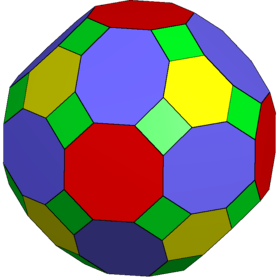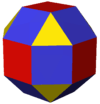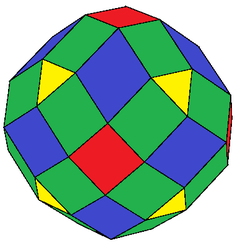Truncated rhombicuboctahedron
The truncated rhombicuboctahedron is a polyhedron, constructed as a truncated rhombicuboctahedron. It has 50 faces, 18 octagons, 8 hexagons, and 24 squares. It can fill space with the truncated cube, truncated tetrahedron and triangular prism as a truncated runcic cubic honeycomb.
| Truncated rhombicuboctahedron | |
|---|---|
 | |
| Schläfli symbol | trr{4,3} = |
| Conway notation | taaC |
| Faces | 50: 24 {4} 8 {6} 6+12 {8} |
| Edges | 144 |
| Vertices | 96 |
| Symmetry group | Oh, [4,3], (*432) order 48 |
| Rotation group | O, [4,3]+, (432), order 24 |
| Dual polyhedron | Disdyakis icositetrahedron |
| Properties | convex, zonohedron |
Other names
- Truncated small rhombicuboctahedron
- Beveled cuboctahedron
Zonohedron
As a zonohedron, it can be constructed with all but 12 octagons as regular polygons. It has two sets of 48 vertices existing on two distances from its center.
It represents the Minkowski sum of a cube, a truncated octahedron, and a rhombic dodecahedron.
Excavated truncated rhombicuboctahedron
| Excavated truncated rhombicuboctahedron | |
|---|---|
| Faces | 148: 8 {3} 24+96+6 {4} 8 {6} 6 {8} |
| Edges | 312 |
| Vertices | 144 |
| Euler characteristic | -20 |
| Genus | 11 |
| Symmetry group | Oh, [4,3], (*432) order 48 |
The excavated truncated rhombicuboctahedron is a toroidal polyhedron, constructed from a truncated rhombicuboctahedron with its 12 irregular octagonal faces removed. It comprises a network of 6 square cupolae, 8 triangular cupolae, and 24 triangular prisms. [1] It has 148 faces (8 triangles, 126 squares, 8 hexagons, and 6 octagons), 312 edges, and 144 vertices. With Euler characteristic χ = f + v - e = -20, its genus (g = (2-χ)/2) is 11.
Without the triangular prisms, the toroidal polyhedron becomes a truncated cuboctahedron.
 |
 |
| Truncated rhombicuboctahedron | Truncated cuboctahedron |
|---|
Related polyhedra
The truncated cuboctahedron is similar, with all regular faces, and 4.6.8 vertex figure.
The triangle and squares of the rhombicuboctahedron can be independently rectified or truncated, creating four permutations of polyhedra. The partially truncated forms can be seen as edge contractions of the truncated form.
The truncated rhombicuboctahedron can be seen in sequence of rectification and truncation operations from the cuboctahedron. A further alternation step leads to the snub rhombicuboctahedron.
| Name | r{4,3} | rr{4,3} | tr{4,3} | Rectified rrr{4,3} |
Partially truncated | Truncated trr{4,3} |
srCO | |
|---|---|---|---|---|---|---|---|---|
| Conway | aC | aaC=eC | taC=bC | aaaC=eaC | dXC | dXdC | taaC=baC | saC |
| Image |  |
 |
 |
 |
 |
 |
 |
 |
| VertFigs | 3.4.3.4 | 3.4.4.4 | 4.6.8 | 4.4.4.4d and 3.4.4d.4 |
4.4.4.6i and 4.6.6i |
4.6i.8 and 3.4.6i.4 |
4.8.8p and 4.6.8p |
3.3.3.3.4 and 3.3.4.3.4 |
References
- Eppstein, David (1996). "Zonohedra and zonotopes". Mathematica in Education and Research. 5 (4): 15–21.
- Coxeter Regular Polytopes, Third edition, (1973), Dover edition, ISBN 0-486-61480-8 (pp. 145–154 Chapter 8: Truncation)
- John H. Conway, Heidi Burgiel, Chaim Goodman-Strauss, The Symmetries of Things 2008, ISBN 978-1-56881-220-5
External links
- George Hart's Conway interpreter: generates polyhedra in VRML, taking Conway notation as input
- Prism Expansions Toroid model